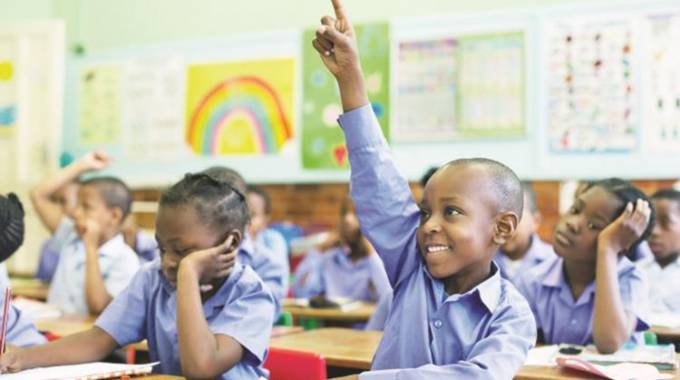Brilliant idea needs resources to work

Monica Cheru Creative Editor
Forty years after Independence, Zimbabwe finally has a law declaring basic education compulsory for all children.
The Education Amendment Act, signed into law last Friday, states that “every child shall be entitled to compulsory basic State-funded education” and reinforces this with punishment for parents and guardians who deprive children of the opportunity.
Effectively, Zimbabwe has upped to 13 years of compulsory education, from seven years that were put in place post-Independence to achieve the Government’s education for all goal.
The country joins a relatively small group of nations — including Chile, Belgium, Italy, Norway, Britain and New Zealand — which have over 10 years of compulsory education.
Now Zimbabwe needs to walk the talk to ensure access to education is indeed a universal right and no child is left behind.
Currently, the country has been recognised on paper as one of the nations in Africa with compulsory education at primary school level.
But the reality is that there have been gaps.
With school dropout rates above 12 percent with some of the learners dropping out in primary school, the situation on the ground does not match the ideals of the policies and laws.
The new Act affords Government an opportunity to redress that and achieve education for all in deed, and not just on paper.
In this instalment, I give an overview of hindrances which the Government must act on urgently.
Inadequate schools
A growing number of learners are being forced into the private education system because public schools are overwhelmed.
There are too many learners without access to public schools because there is just no room to accommodate them.
Practically, there must be adequate public school facilities. The country has enough teachers and facilities to train adequate numbers to meet demand. The challenge is on the actual schools and the capacity of the existing ones. Government needs to build more schools to meet population growth projections.
Education funding models
In the current set up, the State mostly looks after teacher remuneration, while parents finance the operational costs of education through fees and levies.
In fact, right now in certain public schools, parents have taken over the burden through incentives paid to teachers.
Social welfare programmes are not enough to protect all vulnerable children and some still drop out of school because of poverty. Without a new funding model for public schools, the 13 years of compulsory education will not be enforceable, just as the seven years have not been. It is heartening to note that the new Act specifically exhorts local authorities to provide land for schools. But that is not enough.
I have previously urged local authorities to take full responsibility and provide infrastructure and resources for public schools in their jurisdictions.
There is need to develop that further and look at the construction of new schools, then operational costs of running the schools.
Private schools have mushroomed to cover gaps created by declining standards and the poor quality of delivery in public schools.
Hidden costs of education
According to the amended Act, school fees and levies remain in place, but children in need will be funded by the Government so no parent or guardian can use the excuse of poverty to keep children out of school.
Unfortunately this does not take into consideration the hidden costs of education which are very high.
The biggest such cost in Zimbabwe are school uniforms which are very expensive.
In certain cases, for public schools, a single set of uniforms and accessories costs more than fees and levies paid for the whole year.
The curriculum being introduced in schools demands high commitment from parents and guardians in the form of resources that are needed for effective learning to take place. Stationery, trips and other needs can also be prohibitive for the economically marginalised, thus limiting their access to education.
Teen pregnancies
Zimbabwe has a high teen pregnancy rate with statistics putting the number of girls getting pregnant in any given year at over 6 000.
Policy says pregnant girls must no longer drop out of school. But the reality is that there is no support system to protect pregnant teens and give them a second chance of getting a full education. A number of them end up in early marriages which perpetuate the poverty cycle.
There is discrimination and stigmatisation that hound the girls out of school.
There are also rigid school authority figures who run institutions according to their own moral standpoints and will not countenance a pregnant pupil attending lessons, usually claiming that this will have negative peer influence on the rest of the learners.
Then there is the cost.
Most girls from disadvantaged backgrounds who get pregnant cannot afford child care. Also many parents will no longer be willing to continue meeting educational expenses for a girl who has fallen pregnant.
Registration documents
There are many Zimbabwean children with no registration documents for one reason or another. Some are the offspring of people who left the country several years ago and have not returned because they are illegal residents in the countries that they are domiciled in.
Yet others are the children of teen mothers who have no idea how to register the birth of the child. Some children are orphans.
There are also hiccups, long queues and a whole load of stress factors at the Registry offices that hinder the acquisition of registration documents.
Without an identity one is not able to register in a public school or sit for a public examination. This is a roadblock for the neediest of citizens that needs to be removed. Acquisition of registration documents should be easier for Zimbabwean children. The right to a name and identity is key in accessing the right to an education.
Grey areas
There are grey areas in the amendment Act as it does not abolish school fees, clearly stating that the Education Minister shall continue to set school fees at State schools and when doing so shall take into account the “location and status” of the schools.
Effectively that means that there is no free education.
Just that all children must be in school. So the journey to universal education is not yet ended. There is still much work to be done until Government can provide free and quality education to all.
The writer is a former high school teacher and a textbook author. [email protected]








Comments